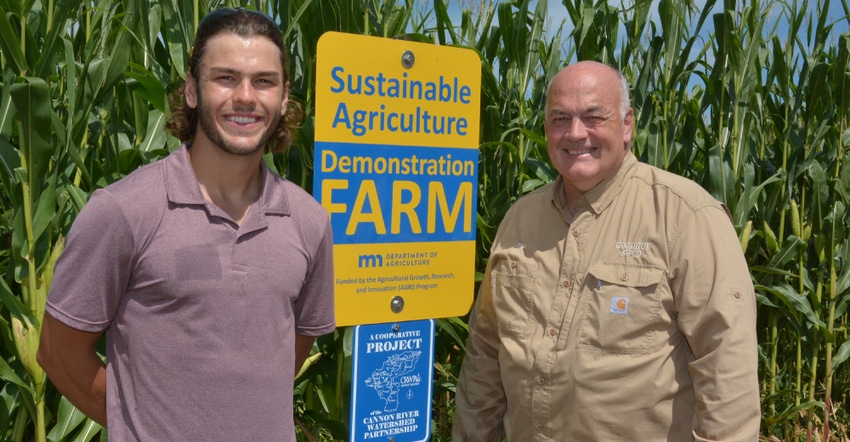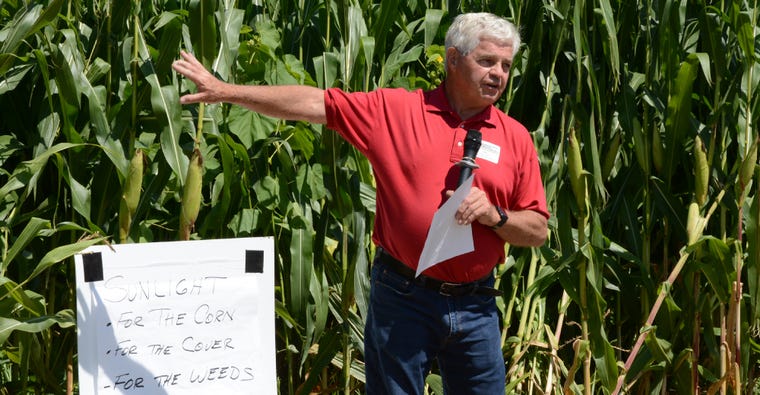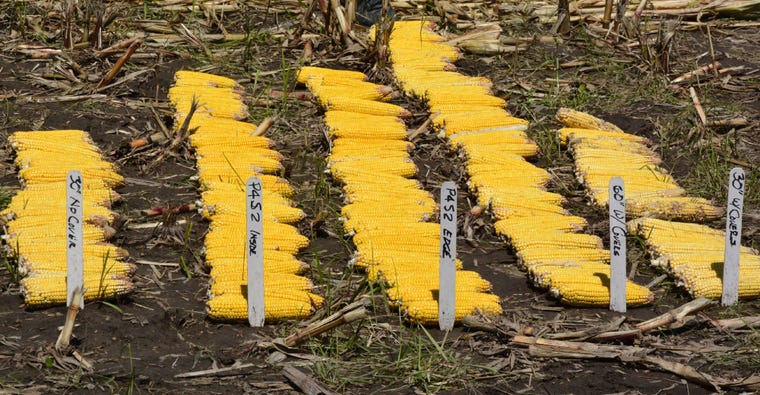
Planting corn between wide rows of vegetation is getting a fresh look by some farmers and conservationists interested in improving soil health and providing forage for grazing livestock.
Alan Krause, conservation program manager for the Cannon River Watershed Partnership, along with M. Scott Wells, an agronomy professor at the University of Minnesota, are working with four farmers in Goodhue and Rice counties on a three-year wide-row corn project, which is evaluating the effect of corn row width on cover crop biomass and corn grain yields. The upcoming 2021 growing season will be their third year in the trial.
Over the past two years, each farm established a 20-acre site to evaluate replicated control and treatment plots of cover crops interseeded into rows of corn 30, 60 and 90 inches wide. Cover crop mixes were selected for high forage yield and quality, and interseeded into knee-high corn in July with modified drills and air seeders.
Getting cover crops established is one of the challenges that discourages some farmers from trying them. Widening the rows between corn lets the sun in when interseeding.
“In the past, we’ve tried to get bigger leaves to get bigger corn,” explains Ed McNamara, one of the farmers involved in the project who farms near Goodhue, Minn., with his family. “But it’s hard to get cover crops established under that. We know that the outside two rows of corn are always more productive than the next rows in. So, we thought, let’s try 60-inch row corn and then we tried 90-inch corn.”
To get 90-inch row spacing, they shut off two-row units, which provided 90 inches from planted row to planted row for cover crop seeding. To get 60-inch rows, they shut off every other row on the planter.
2019 overview
Wet weather delayed corn planting by 10 to 20 days from normal, depending on farm location, which in turn set the cover crop interseeding back from an ideal mid-June planting, Kraus says. Corn planting dates ranged from May 5 to June 5, with interseeding from June 11-29.
Ongoing wet weather helped cover crop establishment and growth, but ended up negatively impacting corn yields on all four farms. Plus, continued adverse weather delayed fall grain harvest, eliminating the planned mechanical harvest of the cover crops on two farms and only allowing a fall grazing of the cover crops after grain was harvested on the other two farms.

While corn yield took a hit, cover crop biomass yield within the 90-inch rows was significant when compared to the 60-inch and 30-inch row treatments, offering just over 1,600 pounds of forage dry matter per acre available for grazing or mechanical harvest. Cover crop biomass quality was high, ranging in relative feed value of 145 in the 30-inch row treatment to 191 RFV for the biomass in the 60-inch row. Crude protein of the cover crop biomass was consistent between treatments at 23%.
2020 weather better
The 2020 growing season opener couldn’t have been much better. Planting got done by early May and cover crops were interseeded three weeks after the corn. McNamara noted the cover crop provided weed suppression, yet some species such as kale overwhelmed the plot.
“We’re still trying to dial in on the mix,” McNamara says. “People tell us to plant brassicas, legumes and grass. The brassicas took off, but the annual ryegrass disappeared.”
Last year, McNamara planted a cover crop mix of annual ryegrass, red and crimson clover, kale, turnip, and radish.
Researchers have yet to publish overall results for 2020 since COVID-19 has impacted testing and analysis. A report may come out in late February.
In his plots, McNamara says he saw a 20-bushel yield hit between 30-inch corn versus 60-inch corn, or a difference of $70 per acre with $3.50-per-bushel corn. If the 2020 biomass numbers are similar to those in 2019, biomass from 60-inch rows would be 1,200 to 1,300 pounds per acre and just under a ton for 90-inch rows. RFV was around 190, equating to a feed value of $190 per ton.
Another cooperating farmer, Jim Purfeerst of Faribault, Minn., says 2020 had fabulous growing conditions in his area. He finished planting corn April 23 and interseeded cover crops at V3 to V4.
“We went to all conventional corn a year ago, so we did struggle a little bit with weed control,” Purfeerst says. He has been planting cover crops for nearly a decade and normally operates with a corn-soybean rotation, which clears up weed issues. But growing corn on corn for the trial presented some weed challenges.
Overall, his cover crops grew well. Using 30-inch corn without cover as a baseline for comparison:
30-inch corn with cover yielded 3% better
60-inch corn yield with cover dropped 8%
90-inch corn yield dropped 14%

Cover crop biomass production was high: 200 pounds dry matter from 30-inch rows, 800 pounds DM in 60-inch and 2,800 pounds DM in 90-inch.
For this growing season, the project will undergo a few tweaks. Kraus, Wells and the four farmers discussed ways to make the project more uniform, as well as reducing plot sizes and modifying seed population numbers in the 60-inch rows. Plus, they may fine-tune fertility application, such as placing nitrogen next to corn instead of on the cover crop row.
Even with the extra crop management effort needed for the project, both McNamara and Purfeerst appreciate the experience.
“It’s been a fun project to work on,” Purfeerst says.
Adds McNamara: “It’s like life. The program is a work in progress.”
For more information on the regenerative ag project, contact Kraus at [email protected] or Wells at [email protected].
About the Author(s)
You May Also Like






